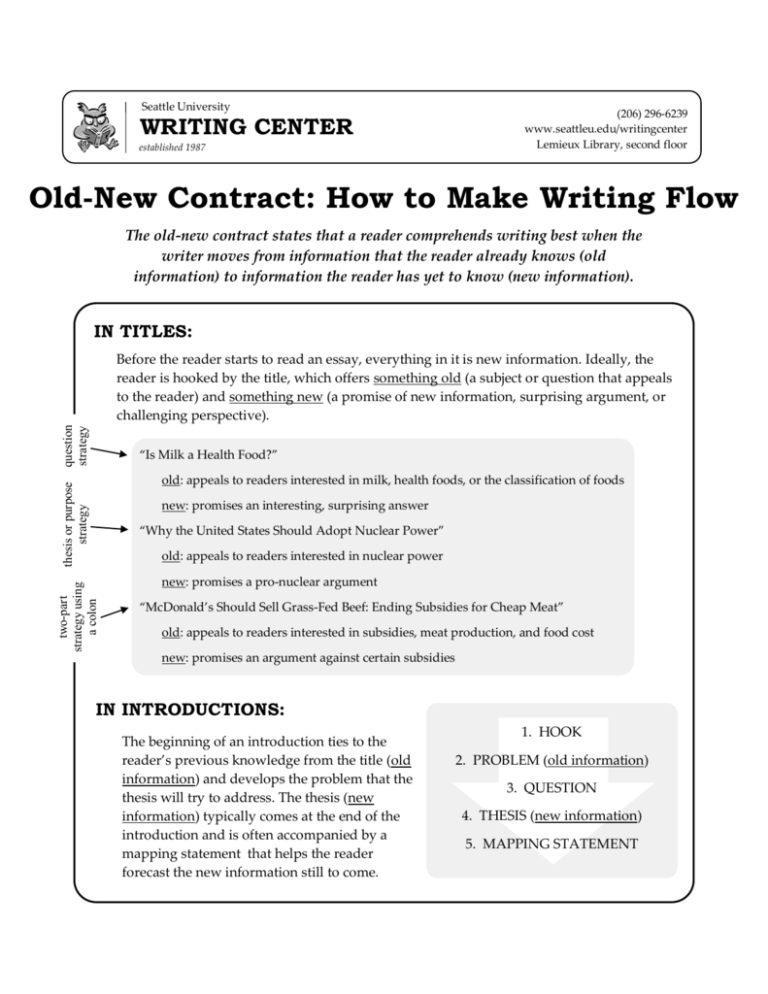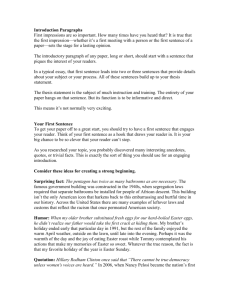Old-New Contract - Seattle University
advertisement

Seattle University WRITING CENTER established 1987 (206) 296-6239 www.seattleu.edu/writingcenter Lemieux Library, second floor Old-New Contract: How to Make Writing Flow The old-new contract states that a reader comprehends writing best when the writer moves from information that the reader already knows (old information) to information the reader has yet to know (new information). IN TITLES: question strategy Before the reader starts to read an essay, everything in it is new information. Ideally, the reader is hooked by the title, which offers something old (a subject or question that appeals to the reader) and something new (a promise of new information, surprising argument, or challenging perspective). “Is Milk a Health Food?” thesis or purpose strategy old: appeals to readers interested in milk, health foods, or the classification of foods new: promises an interesting, surprising answer “Why the United States Should Adopt Nuclear Power” two-part strategy using a colon old: appeals to readers interested in nuclear power new: promises a pro-nuclear argument “McDonald’s Should Sell Grass-Fed Beef: Ending Subsidies for Cheap Meat” old: appeals to readers interested in subsidies, meat production, and food cost new: promises an argument against certain subsidies IN INTRODUCTIONS: The beginning of an introduction ties to the reader’s previous knowledge from the title (old information) and develops the problem that the thesis will try to address. The thesis (new information) typically comes at the end of the introduction and is often accompanied by a mapping statement that helps the reader forecast the new information still to come. 1. HOOK 2. PROBLEM (old information) 3. QUESTION 4. THESIS (new information) 5. MAPPING STATEMENT Seattle University QUICKTIPS WRITING CENTER established 1987 Transitions Old-new contract can also be practiced on the sentence level by using transitional words or phrases. Transitions function as signposts, signaling to the reader that the road is turning. (You wouldn’t like for the reader to drive off a cliff, would you?) FUNCTION sequence WORDS OR PHRASES first, second, third, next, finally, earlier, later, meanwhile, afterward restatement that is, in other words, to put it another way replacement rather, instead example for example, for instance, case in point reason because, since, for consequence therefore, hence, so, consequently, then, as a result, accordingly, as a consequence denied consequence still, nevertheless, even so concession although, even though, granted that similarity in comparison, likewise, similarly contrast however, in contrast, conversely, on the other hand, but, on the contrary addition in addition, also, moreover, furthermore conclusion in brief, in sum, in short, in conclusion, to sum up, to conclude © Seattle University Writing Center | October 2012 content adapted from “Teaching Old-Before-New” by Dr. John Bean “The Science of Scientific Writing” by George Gopen and Judith Swan * For more tips like these, check out seattleu.edu/writingcenter/resources.







